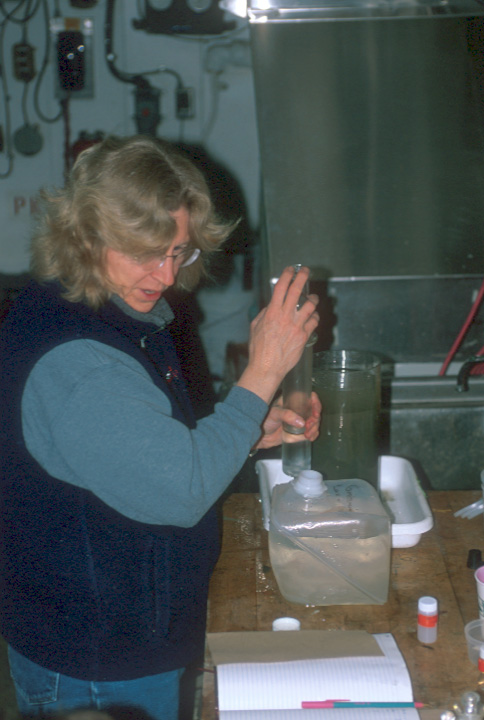Science on board the USCG Polar Star 

Navy and Coast Guard divers participating in under-ice dive operations. During the practice, they also collected video footage and biological samples for the scientists.
The best of both worlds: Dive equipment, including dry suits and voice-activated helmets, was valued in the thousands of dollars for each diver. Science samples were collected with a butterfly net and a Skippy peanut butter jar. The platform to lower the divers onto the ice was nicknamed the polar bear appetizer tray by onlookers (Photos by J. Bump) |  |

Dr. Jackie Grebmeier, one of the primary investigators of SLIPP '01, conducting onboard chamber respiration experiments in the lab. (Photo by J. Bump) 
Above: Overhead view of Conductivity-Temperature-Density (CTD)rosette being prepared for deployment. (Photo by J. Bump) |
|
|
|  | 
Above: Dredge being prepared for deployment. It scrapes along the bottom and collects animals living on the surface of the sediment (epifauna) and animals living in the sediment itself (infauna). (Photo by J. Bump) 
Above: Container of organisms collected by the dredge. The sediment has already been rinsed off. (Photo by J. Bump) 
Above: A brightly colored male Spectacled Eider diving sea duck. One of the missions of SLIPP '01 was to study the wintering grounds of this endangered bird. It dives to the bottom of the shallow Bering Sea water to feed on clams. Not only does the Spectacled Eider retain high levels of poisonous metals in its body tissues from lead shot at its Alaskan land-based nesting grounds, but the clam food source is changing in species composition and abundance. Dr. Jackie Grebmeier and Dr. Lee Cooper are working with co-Primary Investigator Dr. Jim Lovvorn of the University of Wyoming, in order to study this problem. (Photo by J. Lovvorn) 
Please visit the UT Arctic web page to view incredible movie clips of these helicopter eider surveys! Above: Hundreds of thousands of Spectacled Eiders resting in an ice lead. The entire world population of these birds are theorized to overwinter in the Saint Lawrence Island Polynya region (a phenomenon only recently discovered by one radio-collar momentarily blinking on after many months of silence, allowing scientists to trace it to SLIP, after all of the other radio-collars placed on eiders had disappeared from satellite tracking), but it is difficult to include Russian estimates, since U.S. scientists have not yet been allowed to survey the Russian coastline bird populations. (Photo by J. Lovvorn) |


